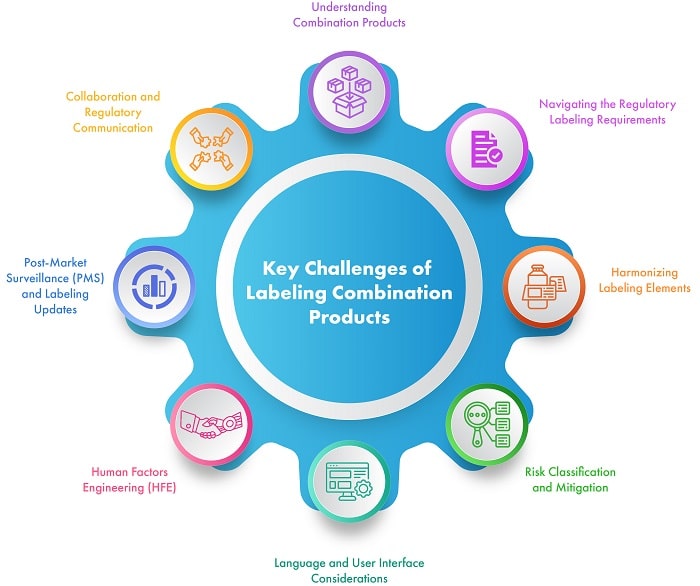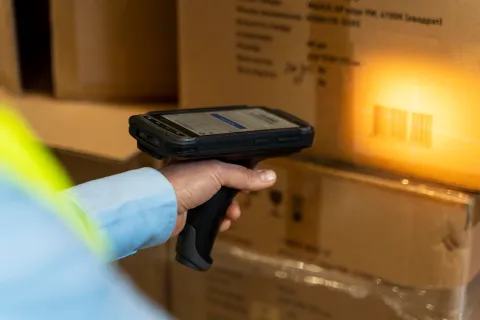
Combination products, or products that combine medicines, devices, or biologics pose special Regulatory labeling problems. As these products consist of multiple components and varying Regulatory standards, manufacturers must ensure that they comply with all the individual requirements and properly convey safety information.
This blog explores the challenges of labeling combination products and provides strategies for navigating the Regulatory labeling requirements while prioritizing patient safety and compliance. Figure 1 below highlights the main challenges of labeling combination products.

Figure 1: Key Challenges of Labeling Combination Products
Let us now look at each challenge in detail:
- Understanding Combination Products: Combination products combine various components, for instance, a product made of a drug and a device, to offer innovative treatment choices. However, the convergence of different Regulatory frameworks and requirements can complicate their labeling process. It is therefore critical to recognize the fundamental method of operation and pertinent regulation(s) for each component.
- Navigating the Regulatory Labeling Requirements: Combination products must adhere to both drug and device laws, which makes it necessary to navigate multiple Regulatory pathways. Collaborate closely with Regulatory Affairs experts to understand and address specific labeling requirements set forth by agencies such as the United States Food and Drug Administration (USFDA), European Medicines Agency (EMA), and other relevant authorities.
- Harmonizing Labeling Elements: Harmonizing labeling elements across different components of combination products are crucial for providing clear and consistent information to healthcare professionals and patients. Ensure that the labeling accurately represents the combined functionality and conveys essential instructions, warnings, and Instructions for Use (IFUs).
- Risk Classification and Mitigation: Identify and classify the risks associated with each component of the combination product. Assess the potential risks and determine the appropriate mitigation strategies. Communicate these risks, along with the corresponding precautions and warnings on the product label, to ensure patient safety and adherence to the Regulatory labeling requirements.
- Language and User Interface Considerations: Consider the linguistic requirements for labeling when marketing combination products internationally. Translate and localize the labeling content to be compliant with regulations in different regions and accommodate the language preferences of the target audience. Additionally, design user-friendly interfaces that facilitate the safe and effective use of combination products.
- Human Factors Engineering (HFE): The usability of combination products is critical to ensuring patient safety. Apply HFE principles to ensure that the labeling and user instructions are intuitive, easily comprehensible, and compatible with the user interface of the device component. Conduct usability testing and iterate on the design to reduce the risk of errors and optimize the user experience.
- Post-market Surveillance (PMS) and Labeling Updates: Continuously monitor the safety and performance of combination products through PMS. Promptly capture and analyze adverse events and emerging safety concerns. Update labeling, as and when necessary, to reflect any new information, safety warnings, or changes in indications.
- Collaboration and Regulatory Communication: Labeling of combination products requires close collaboration between the Regulatory, quality, and marketing teams. Establish effective communication channels with Regulatory authorities to seek guidance, clarify the requirements, and ensure compliance throughout the labeling process. Leverage the expertise of cross-functional teams to develop comprehensive and compliant labeling.
Conclusion
Labeling combination products involves navigating complex Regulatory frameworks, addressing risk classification, and ensuring effective communication of safety information. By understanding the unique challenges, harmonizing labeling elements, and leveraging Regulatory expertise, manufacturers can handle the challenges with ease and prioritize compliance and patient safety.
Pay diligent attention to the Regulatory requirements and accurately label your combination products, allowing healthcare professionals and patients to use them safely and effectively. Partnering with an expert like Freyr can minimize your efforts. Contact us to know more!









